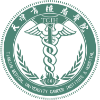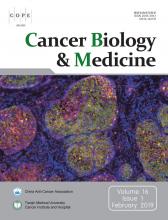Research ArticleOriginal Article
Reactive capillary hemangiomas: a novel dermatologic toxicity following anti-PD-1 treatment with SHR-1210
Xuelian Chen, Lanying Ma, Xi Wang, Hongnan Mo, Dawei Wu, Bo Lan, Dong Qu, Hongtu Zhang, Jing Huang and Binghe Xu
Cancer Biology & Medicine February 2019, 16 (1) 173-181; DOI: https://doi.org/10.20892/j.issn.2095-3941.2018.0172
Xuelian Chen
1State Key Laboratory of Molecular Oncology and Department of Medical Oncology, National Cancer Center, National Clinical Research Center for Cancer, Cancer Hospital Chinese Academy of Medical Sciences & Peking Union Medical College-Medical Oncology, Beijing 100021, China
Lanying Ma
2Department of Gastroenterology, Tumor Hospital Affiliated to Xinjiang Medical University, Tumor Hospital Affiliated to Xinjiang Medical University, Urumchi 830000, China
Xi Wang
1State Key Laboratory of Molecular Oncology and Department of Medical Oncology, National Cancer Center, National Clinical Research Center for Cancer, Cancer Hospital Chinese Academy of Medical Sciences & Peking Union Medical College-Medical Oncology, Beijing 100021, China
Hongnan Mo
1State Key Laboratory of Molecular Oncology and Department of Medical Oncology, National Cancer Center, National Clinical Research Center for Cancer, Cancer Hospital Chinese Academy of Medical Sciences & Peking Union Medical College-Medical Oncology, Beijing 100021, China
Dawei Wu
1State Key Laboratory of Molecular Oncology and Department of Medical Oncology, National Cancer Center, National Clinical Research Center for Cancer, Cancer Hospital Chinese Academy of Medical Sciences & Peking Union Medical College-Medical Oncology, Beijing 100021, China
Bo Lan
1State Key Laboratory of Molecular Oncology and Department of Medical Oncology, National Cancer Center, National Clinical Research Center for Cancer, Cancer Hospital Chinese Academy of Medical Sciences & Peking Union Medical College-Medical Oncology, Beijing 100021, China
Dong Qu
3Department of Diagnostic Radiology
Hongtu Zhang
4Department of Pathology, National Cancer Center, National Clinical Research Center for Cancer, Cancer Hospital Chinese Academy of Medical Sciences & Peking Union Medical College-Medical Oncology, Beijing 100021, China
Jing Huang
1State Key Laboratory of Molecular Oncology and Department of Medical Oncology, National Cancer Center, National Clinical Research Center for Cancer, Cancer Hospital Chinese Academy of Medical Sciences & Peking Union Medical College-Medical Oncology, Beijing 100021, China
Binghe Xu
1State Key Laboratory of Molecular Oncology and Department of Medical Oncology, National Cancer Center, National Clinical Research Center for Cancer, Cancer Hospital Chinese Academy of Medical Sciences & Peking Union Medical College-Medical Oncology, Beijing 100021, China

References
- 1.↵
- 2.↵
- Belum VR,
- Benhuri B,
- Postow MA,
- Hellmann MD,
- Lesokhin AM,
- Segal NH, et al.
- 3.↵
- Ciccarese C,
- Alfieri S,
- Santoni M,
- Santini D,
- Brunelli M,
- Bergamini C, et al.
- 4.↵
- Postow MA,
- Callahan MK,
- Wolchok JD.
- 5.↵
- Curry JL,
- Tetzlaff MT,
- Nagarajan P,
- Drucker C,
- Diab A,
- Hymes SR, et al.
- 6.↵
- Huang J,
- Xu BH,
- Mo HN,
- Zhang WL,
- Chen XL,
- Wu DW, et al.
- 7.↵
- 8.↵
- 9.↵
- George A,
- Mani V,
- Noufal A.
- 10.↵
- 11.↵
- Ji Y,
- Chen SY,
- Li K,
- Li L,
- Xu C,
- Xiang B.
- 12.↵
- Laken PA.
- 13.↵
- Chang LC,
- Haggstrom AN,
- Drolet BA,
- Baselga E,
- Chamlin SL,
- Garzon MC, et al.
- 14.↵
- 15.↵
- Fujiwara C,
- Motegi SI,
- Sekiguchi A,
- Amano H,
- Ishikawa O.
- 16.
- 17.
- Massa A,
- Antunes A,
- Varela P.
- 18.↵
- Simmons BJ,
- Chen L,
- Hu S.
- 19.↵
- 20.↵
- 21.↵
- Patil A,
- Pattanshetti C,
- Varekar A,
- Huddar SB.
- 22.↵
- Weber JS,
- Yang JC,
- Atkins MB,
- Disis ML.
- 23.↵
- Hua C,
- Boussemart L,
- Mateus C,
- Routier E,
- Boutros C,
- Cazenave H, et al.
- 24.
- Byrne KT,
- Turk MJ.
- 25.↵
- 26.↵
- Bonigen J,
- Raynaud-Donzel C,
- Hureaux J,
- Kramkimel N,
- Blom A,
- Jeudy G, et al.
In this issue
Reactive capillary hemangiomas: a novel dermatologic toxicity following anti-PD-1 treatment with SHR-1210
Xuelian Chen, Lanying Ma, Xi Wang, Hongnan Mo, Dawei Wu, Bo Lan, Dong Qu, Hongtu Zhang, Jing Huang, Binghe Xu
Cancer Biology & Medicine Feb 2019, 16 (1) 173-181; DOI: 10.20892/j.issn.2095-3941.2018.0172
Reactive capillary hemangiomas: a novel dermatologic toxicity following anti-PD-1 treatment with SHR-1210
Xuelian Chen, Lanying Ma, Xi Wang, Hongnan Mo, Dawei Wu, Bo Lan, Dong Qu, Hongtu Zhang, Jing Huang, Binghe Xu
Cancer Biology & Medicine Feb 2019, 16 (1) 173-181; DOI: 10.20892/j.issn.2095-3941.2018.0172
Jump to section
Related Articles
- No related articles found.
Cited By...
- Variable PD-1 glycosylation modulates the activity of immune checkpoint inhibitors
- Variable PD-1 glycosylation modulates the activity of immune checkpoint inhibitors
- An eruption of dome-shaped, red papules
- Efficacy and Biomarker Analysis of Camrelizumab in Combination with Apatinib in Patients with Advanced Nonsquamous NSCLC Previously Treated with Chemotherapy










